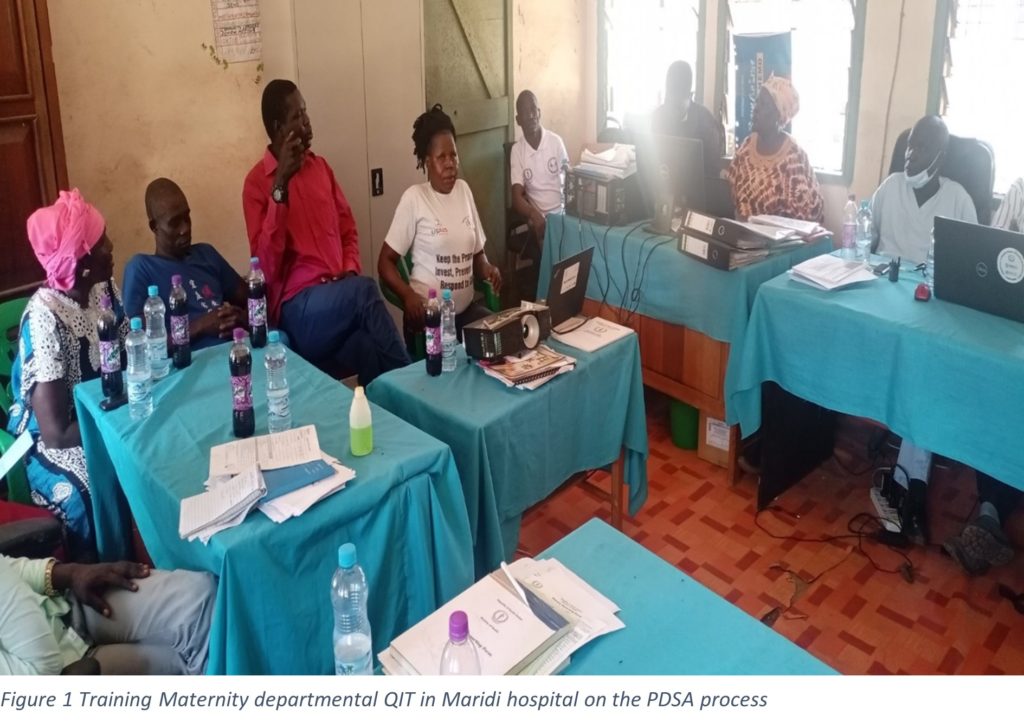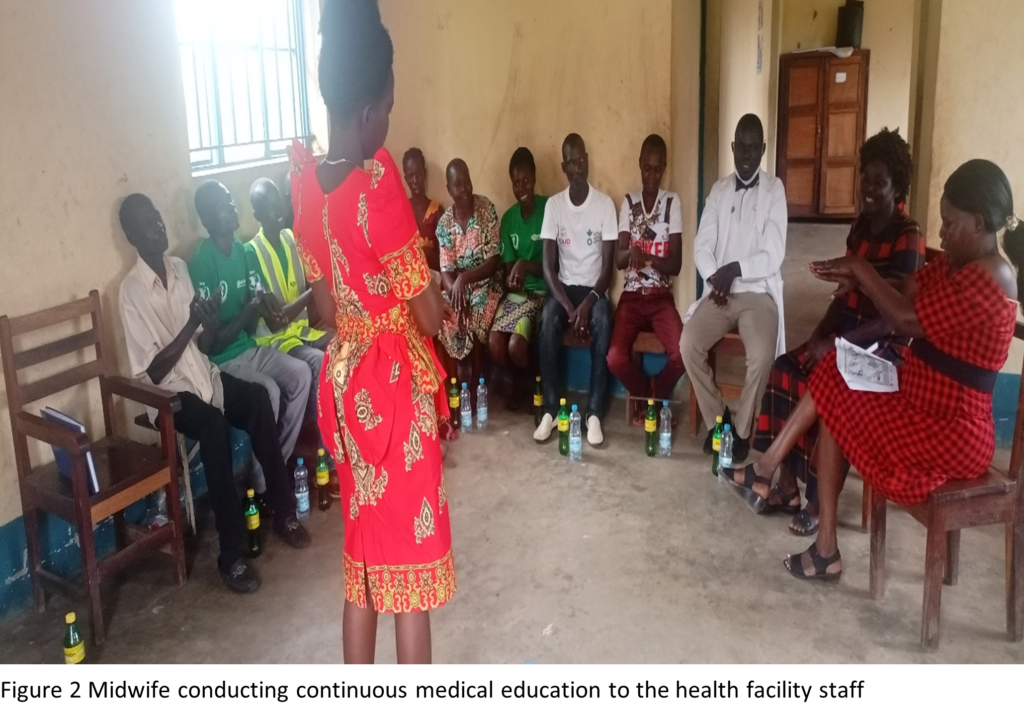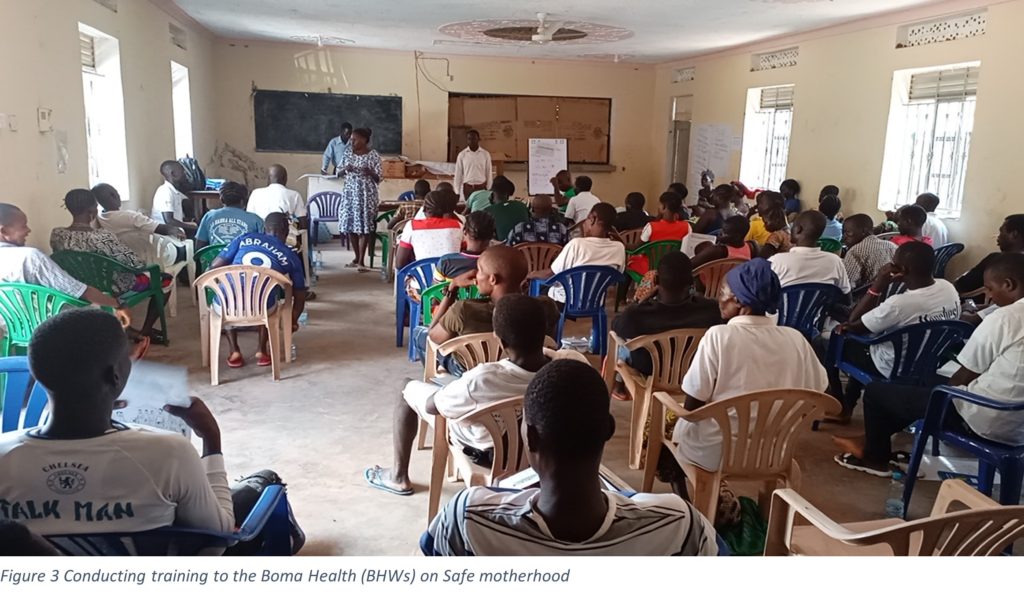Success Story: Reduction in maternal mortality in Maridi County Hospital – South Sudan
In South Sudan, women and girls are likely to experience adverse maternal health outcomes. They often face discrimination and abuse, which leads to increased maternal morbidities and mortalities in health facilities.
Amref Health Africa – South Sudan is currently implementing a primary health care project, funded by the Health Pooled Fund (HPF) to improve maternal health outcomes in Maridi County of Western Equatorial State. The project supports the county hospital, primary health care units (PHCUs), and primary health care centres (PHCCs). Maridi county hospital is the only referral hospital serving a population of about one hundred and twenty-two thousand seven hundred and sixty-four (122764) in Maridi County and over a hundred thousand (107311) in Ibba County. The hospital registered 5 maternal mortalities between January and June 2022 due to direct and indirect causes, and predisposing factors.
The direct causes of maternal mortalities at Maridi county hospital include but are not limited to post-partum haemorrhage, pre-eclampsia and eclampsia, sepsis – secondary to complications from abortion, rupture of the uterus and obstructed labour. Maternal mortalities may also be due to indirect causes such as effects of pre-existing conditions like malaria in pregnancy, HIV infection, anaemia in pregnancy, chronic and acute heart diseases, and diabetes among others.[1]
Some of the predisposing factors to maternal death are poverty, ignorance, the high illiteracy rate among women of childbearing age, cultural beliefs, limited access to antenatal care (ANC), home deliveries by unskilled birth attendants (TBA), poor attitude of the health care workers towards mothers during delivery (lack of respectful maternity care), lack of transport to the health facility, poor road network, delay on making the decision to seek health care services, insecurity, lack of qualified health workers, inadequate health equipment and supplies, lack of network for communication in the remote areas, hindering prompt referral of the pregnant mothers, and poor quality of care among others.[2]
A baseline assessment of the hospital was done using both the HPF QoC pilot accessory tool and the routine QoC Mobile Application. The QIT selected the following gaps to focus on:
- A low proportion (fifty per cent) of women whose labour was monitored using a partograph.
- Lack of continuous medical education (CME) conducted at the hospital.
- Limited health education sessions on the importance of hospital delivery during ANC.
- An inadequate referral system from the health facilities within the catchment area, and frequent breakdown of the referral ambulance.
During the baseline assessment, it was established that partographs were used to correctly monitor only fifty per cent of mothers in labour during childbirth. This was attributed to only thirty-eight per cent (5/13) of midwives working in the maternity ward who could correctly fill out the World Health Organisation (WHO) labour guide (Partograph); the facility lacked partographs and had a poor storage, and filing system.
To mitigate this, a one-day training on how to fill the new WHO Partograph correctly was held for all the midwives in the maternity ward. After the training, sixty-two per cent (8/13) of the midwives in the maternity ward were able to correctly use the new WHO Partograph to monitor labour, while those who still had some gaps were supported by the senior midwife. By March 2023, up to seventy-seven per cent (10/13) of the midwives were able to fill the partograph correctly. In addition to the training, there was on-job mentorship by the senior midwife to all the midwives. Adequate copies of printed Partographs were availed to the maternity ward, and a good filing and storage system was established. This resulted in one hundred per cent of mothers delivering in Maridi Hospital being monitored using Partographs as of February 2023.
The QIT in their bi-weekly meetings also identified the need for CME sessions and agreed to schedule departmental sessions every Friday. The CME topics included the management of obstetric emergencies, for example, post-partum haemorrhage, pre-eclampsia, and eclampsia. This initiative has equipped all 13 maternity midwives with the knowledge and skills to manage obstetric emergencies, hence reducing maternal mortality.
There were cases reaching the hospital late, after failed home deliveries. This was attributed to the limited health education sessions on the importance of hospital delivery during ANC. To mitigate this, health education sessions were held to sensitise the community about the importance of hospital delivery during the ANC visits. This played a great role in informing mothers to seek facility deliveries at the onset of labour. The Boma health workers (BHWs) were also trained on safe motherhood, which empowered them with the knowledge and skills to identify danger signs in pregnant mothers and refer them to Maridi County Hospital for further management.
Strengthening the referral system in Maridi County Hospital also played an important role in the reduction of maternal mortality. Health Pooled Fund donated a new ambulance to support the referral of pregnant women who develop obstetric and gynaecological complications from the catchment areas to Maridi county hospital for proper management.
Following the interventions above, monitoring labour using the WHO labour care guide, conducting CME, community sensitisation and the health education given to the pregnant mothers during the ANC visits, supported by timely referral of pregnant mothers with obstetric emergencies reduced maternal mortality from 5 mothers between January to June 2022, to only 1 maternal death between July and December 2022. The QIT in Maridi Hospital ensures that the interventions continue, as they have proved to be beneficial in reducing maternal mortality.
[1] Global causes of maternal death: a WHO systematic analysis – The Lancet Global Health
[2] https://pubmed.ncbi.nlm.nih.gov/34717668/
This story was first published on the Montrose Website.



